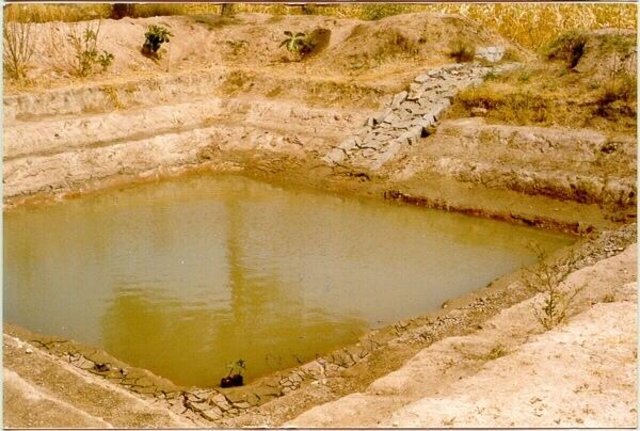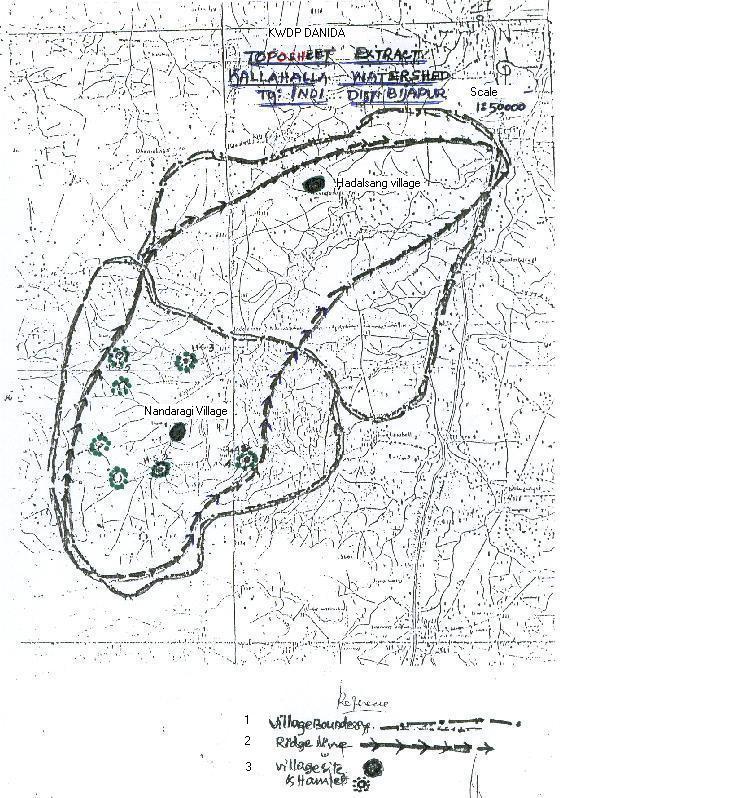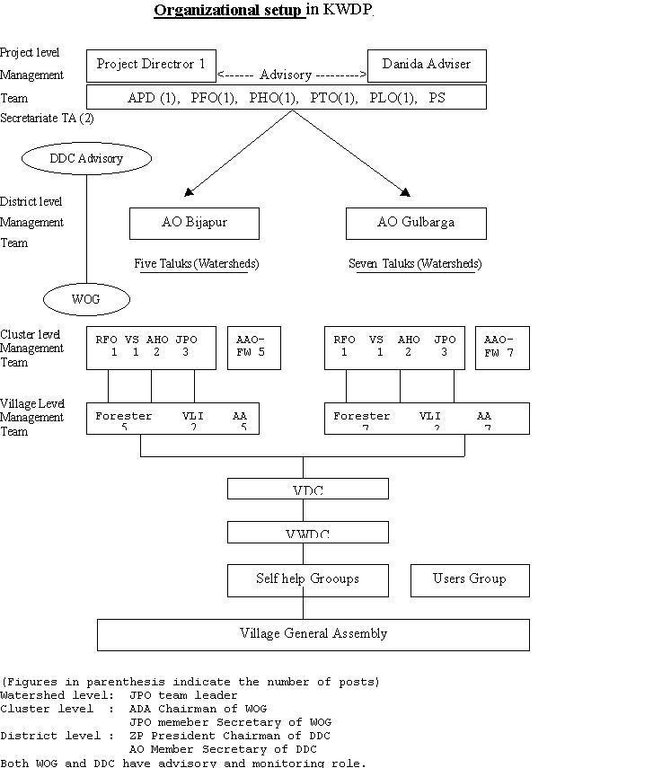Stakeholders participation in the project activities [الهند]
- تاريخ الإنشاء:
- تحديث:
- جامع المعلومات: Pranesh Jahagirdar
- المحرر: –
- المُراجع: Fabian Ottiger
approaches_2373 - الهند
عرض الأقسام
توسيع الكل طي الكل1. معلومات عامة
1.2 تفاصيل الاتصال بالأشخاص الرئيسيين لمصدر المعلومات والمؤسسات المعنية بتقييم وتوثيق النهج
اسم المؤسسة (المؤسسات) التي سهلت توثيق/تقييم النهج (إذا كان ذلك على صلة)
Danida assisted Karnataka Watershed Development Project, Bijapur (Danida assisted Karnataka Watershed Development Project, Bijapur) - الهند1.3 الشروط المتعلقة باستخدام البيانات الموثقة من خلال WOCAT
يوافق جامع المعلومات والشخص (لاشخاص) الرئيسي لمصدر المعلومات على الشروط المتعلقة باستخدام البيانات الموثقة من خلال WOCAT:
نعم
1.4 المراجع الخاصة باستبيان(استبيانات) تقنيات الإدارة المستدامة للأراضي

Farm pond [الهند]
A sunken structure (12 x 12 x 3 m, more suiable), constructed by escavation in arable land with a view of temporary runoff storage tapped for protective irrigation, and to increase percolation for recharge of ground water (to convert surface to subsurface flow)
- جامع المعلومات: Channabasappa Metri
2. وصف نهج الإدارة المستدامة للأراضي
2.1 وصف موجز للنهج
SWC approach is a participatory methodology to empower the community to plan, implement, monitor, evaluate and manage the SWC technology to bring about sustainability
2.2 وصف تفصيلي للنهج
وصف تفصيلي للنهج:
Aims / objectives: (1) to develop a feeling of ownership, (2) to compare the management of assets created during and after the project in the sustainable manner, (3) to develop capacity amongst the weeker section of the community especially women and resource person, (4) to involve the community at every stage of implementation of the project.
Methods: (1) Participatory Rural Appriasal (PRA), (2) village resourse mapping, (3) training and exposure visits, (4) formation of self help groups, users groups, cattle brreders association, (5) sharing of costs and responsibility (6) partnership with other NGOs, (6) establishment of linkages and networking (7) empowering the coimmnunity throough the livelihood support programs
Stages of implementation: (1) creating awareness, (2) PRA excercises, (3) formation of village level institutions, (4) microplanning, (5) capacity building measures, (6) sharing of cost and responsibilities of management of common property resorses, (7) associating with NGOs and other institutions in rural development (example MANAGE, ICRISAT, University of Agricultural Sciences etc)
Role of stakeholders: (A) participants are of four category (1) project staff (government), (2) members of village level institutions, (3) NGOs and other link organizations and other institutions, (4) international donors (B) Roles :- (1) providing technical support and guidance at every stage of implementation, (2) participation at every stage of implementation, sharing of cost and responsibilities (3) Providing additional technical support (4) providing financial support, guidance, monitoring & evaluation at every stage of implementation.
2.3 صور عن النهج
2.5 البلد/المنطقة/المواقع التي تم تطبيق النهج فيها
البلد:
الهند
المنطقة/الولاية/المحافظة:
Krnataka state
Map
×2.6 تواريخ بدء وإنهاء تنفيذ النهج
أشر إلى سنة البدء:
1997
سنة الإنهاء (إذا لم يعد النهج مطبقًا):
2004
2.7 نوع النهج
- قائم على مشروع/برنامج
2.8 الغايات/الأهداف الرئيسية للنهج
The Approach focused on SLM only (farm pond, waterharvesting, holistic demonstration)
(1) to develop a feeling of ownership, (2) to compare the management of assets created during and after the project in the sustainable manner, (3) to develop capacity amongst the weeker section of the community, especially women and resource poors, (4) to involve the community at every stage of implementation of the project
The SLM Approach addressed the following problems: (1) The problem addressed include non involvement of the community at different stages of implementation of the project. (2) Lack of empowerment and capacity for the deprived class of the community
2.9 الظروف التي تمكن أو تعيق تنفيذ التقنية/التقنيات المطبقة بموجب النهج
المعايير والقيم الاجتماعية /الثقافية/ الدينية
- معيق
coming together of different community in the village, (2)over exploitation of natural resources
Treatment through the SLM Approach: organizing the village community into different village level institutions based on their ideology and background, (2) creating awareness about the equitable distribution and organized the users groups
توفر/الوصول إلى الموارد والخدمات المالية
- معيق
lack of funds to carry out the activities (2) lack of feeling of ownership
Treatment through the SLM Approach: offered financial support using the cost, benefit and responsibility sharing concept
الإطار المؤسساتي
- معيق
lack of village level institutions to take effective implementations
Treatment through the SLM Approach: organised in the village community and establishing an authoritative body to plan, implement the structure
الإطار القانوني (حيازة الأراضي، وحقوق استخدام الأراضي والمياه)
- معيق
The existing land ownership, land use rights / water rights moderately hindered the approach implementation The land use rights did not hinder in private land treatments but because of the encroachment of the common land the SWC technology cannot be effectively implemented.
المعرفة حول الإدارة المستدامة للأراضي، والوصول إلى الدعم الفني
- معيق
use of high cost structure for SWC technology
Treatment through the SLM Approach: demonstration of low cost technical structures
3. المشاركة وأدوار الأطراف المعنية
3.1 أصحاب المصلحة المعنيون بالنهج وأدوارهم
- مستخدمو الأراضي المحليون/المجتمعات المحلية
Village level institutiosn like SHG, UG, CBA, VWDC etc. Specific ethnic groups: Labmani community
Men participation is more in VWDC and CBA while women participation is more in SHGs. the long lasting culture that women remain back and the men lead. The same thing was observed during the initial stages hwever there was considerable change in their understanding and attitude in the following years. Small land holders being part of the VWDC having authority to make decision about the activity to be implemented, they come from different SHGs, who are basically resource poor land users
- منظمة غير حكومية
- الحكومة الوطنية (المخططون، صانعو القرار)
Government of India/ Govt. of Karnataka, Department of Agriculture and watershed development department
- منظمة دولية
Danida
3.2 انخراط مستخدمي الأراضي المحليين/المجتمعات المحلية في المراحل المختلفة للنهج
| انخراط مستخدمي الأراضي المحليين/المجتمعات المحلية | حدد من شارك وصف الأنشطة | |
|---|---|---|
| المبادرة/التحفيز | سلبي | Mainly:rapid/participatory rural appraisal; partly: interviews/questionnaires; There were the village meeting (gram sabha), group discussions, participatory rural appriasal tools were implemented. |
| التخطيط | تفاعلي | Mainly: interviews/questionnaires; partly: public meetings; The transect walks with farmers to their individual survey fields during preparation of action plans. |
| التنفيذ | الدعم الخارجي | Mainly: casual labour; partly: responsibility for major steps; The members of various village level institutions like VWDC used to be present while implementation of CWS activities on common land while those on their individual lands were taken care by respective farmers. Here the cost sharing was t |
| الرصد/التقييم | التعبئة الذاتية | Mainly: measurements/observations; partly: reporting; As and when needed evaluation and status of the structures were taken care by both members and also individually. |
| Research | غير موجود |
3.3 مخطط التدفق (إذا كان متاحًا)
3.4 اتخاذ القرار بشأن اختيار تقنية/تقنيات الإدارة المستدامة للأراضي
حدد من الذي قرر اختيار التقنية/التقنيات التي سيتم تنفيذها:
- مستخدمو الأراضي بشكل أساسي، بدعم من متخصصي الإدارة المستدامة للأراضي
اشرح:
the land users want ot implement the activity in consultation with SWC specialists
Decisions on the method of implementing the SLM Technology were made by mainly by land users supported by SLM specialists
4. الدعم الفني وبناء القدرات وإدارة المعرفة
4.1 بناء القدرات/التدريب
هل تم تقديم التدريب لمستخدمي الأراضي / الأطراف المعنيين الآخرين؟:
نعم
حدد من تم تدريبه:
- مستخدمو الأراضي
- planners
شكل التدريب:
- من مزارع إلى مزارع
- مناطق العرض
- اجتماعات عامة
شكل التدريب:
- exposure visits, subject matter trainings
المواضيع المغطاة:
Regular training were conducted on the subject matter and other technical aspects of various SWC to be implemented in the upper reach, middle reach and in the lower reach etc, for the farmers and other members of VLI, along with the regular other trainings on accounting & book keeping, capacity building etc.
4.2 خدمة استشارية
هل يملك مستخدمو الأراضي وصولا إلى خدمة استشارية؟:
نعم
حدد ما إذا كانت الخدمة الاستشارية متوفرة:
- في مراكز دائمة
وصف/تعليقات:
Name of method used for advisory service: group discussion, interaction, exposure visits; Key elements: group discussion, interaction, exposure visits; 1) Advisory service was carried out through: projects own extension structure and agents; Extension staff: mainly government employees 3) Target groups for extension: land users; Activities: subject matter trainings, orientation trainings etc
Advisory service is quite adequate to ensure the continuation of land conservation activities; Since the project staff has complete responsibility of the watershed and since all the staff is government staff, it is adequate for one watershed area.
4.3 تعزيز المؤسسات (التطوير التنظيمي)
هل تم إنشاء أو تعزيز مؤسسات من خلال هذا النهج؟:
- نعم، باعتدال
حدد المستوى (المستويات) التي تم فيها تعزيز أو إنشاء المؤسسات:
- محلي
حدد نوع الدعم:
- بناء القدرات/التدريب
4.4 الرصد والتقييم
هل يشكل الرصد والتقييم جزءا من النهج؟:
نعم
التعليقات:
bio-physical aspects were regular monitored through observations
technical aspects were regular monitored through measurements
socio-cultural aspects were regular monitored through observations
economic / production aspects were regular monitored through measurements
area treated aspects were regular monitored through observations
no. of land users involved aspects were regular monitored through measurements
management of Approach aspects were regular monitored through observations
There were few changes in the Approach as a result of monitoring and evaluation: Like involving the people since day one of the project. First capacity development of the stakeholders and then implementing the activities etc. This would increase the sustainability of the project interventions.
4.5 البحوث
هل كانت البحوث جزءًا من النهج؟:
نعم
أعط تفاصيل إضافية وأشر إلى من قام بالبحوث:
Not applicable
5. التمويل والدعم المادي الخارجي
5.1 الميزانية السنوية لمكون الإدارة المستدامة للأراضي في النهج المذكور
التعليقات (على سبيل المثال المصادر الرئيسية للتمويل/الجهات المانحة الرئيسية):
Approach costs were met by the following donors: international (donation by the donor agency DANIDA): 90.0%; local community / land user(s) (cost sharing): 10.0%
5.3 إعانات لمدخلات محددة (بما في ذلك العمالة)
- معدات
| حدد المدخلات التي تم دعمها | إلى أي مدى | حدد الإعانات |
|---|---|---|
| الآلات | ممول بالكامل | |
- زراعة
| حدد المدخلات التي تم دعمها | إلى أي مدى | حدد الإعانات |
|---|---|---|
| بذور | ممول بالكامل | |
| Seedlings and biocides | ممول جزئيا | |
- بنى تحتية
| حدد المدخلات التي تم دعمها | إلى أي مدى | حدد الإعانات |
|---|---|---|
| Community infrastructure | ممول جزئيا | |
5.4 الائتمان
هل تم توفير ائتمان في إطار نهج أنشطة الإدارة المستدامة للأراضي؟:
كلا
6. تحليل الأثر والتصريحات الختامية
6.1 آثار النهج
هل ساعد النهج مستخدمي الأراضي على تنفيذ وصيانة تقنيات الإدارة المستدامة للأراضي؟:
- لا
- نعم، قليلا
- نعم، باعتدال
- نعم، إلى حد كبير
Improvement in the farm development, orchard, silvi pasture etc., replication of the SWC technology etc.
هل أدى النهج إلى تحسن في مسائل حيازة الأراضي / حقوق المستخدمين التي أعاقت تنفيذ تقنيات الإدارة المستدامة للأراضي؟:
- لا
- نعم، قليلا
- نعم، باعتدال
- نعم، إلى حد كبير
The participatory approach used by the project helped the community to come closure and understand each other problems and work for the village development. The problem is likely to be overcome in the near future.
Did other land users / projects adopt the Approach?
- لا
- نعم، قليلا
- نعم، باعتدال
- نعم، إلى حد كبير
The other watershed development project in neighbourinng villages undertaken by KAWAD has also initiated the formationof cattle breeders association.
6.3 استدامة أنشطة النهج
هل يمكن لمستخدمي الأراضي المحافظة على استدامة ما تم تنفيذه من خلال النهج (بدون دعم خارجي)؟:
- غير مؤكد
إذا كان الجواب لا أو غير متأكد، حدد ذلك وعلق عليه:
At present due to the continuous support and maintenance of the project staff the lnd users are enthusiastic to use the approach to carry out the acivities but it will be premature to comment at this stage whether they continue to use the approach once no one visits them and make a follow up.
6.4 نقاط قوة/مزايا النهج
| نقاط القوة/ المزايا/ الفرص من وجهة نظر مستخدمي الأراضي |
|---|
| it has helped them to learn new technology by involving themselves (How to sustain/ enhance this strength: other project/ programs should involve these) |
| they have developed feeling of ownership (How to sustain/ enhance this strength: other projects/ programs should allow them to make decisions) |
| learnt te importance of living in harmony and resolving the conflicts (How to sustain/ enhance this strength: conflict resolution should be top most priority while implementing other projects/ programs) |
| they feel that their capacity and skills are enhanced by organizing the village level institutions. (How to sustain/ enhance this strength: on going support in terms of training and exposure visits should be continued.) |
| نقاط القوة/ المزايا/ الفرص من وجهة نظر جامع المعلومات أو غيره من الاشخاص الرئيسيين لمصدر المعلومات |
|---|
| Participatory approaches involves all the staeholders (How to sustain/ enhance this strength: in every other projects or programs the approach whould be continued.) |
| The land users should feel the ownership (How to sustain/ enhance this strength: feeling should be continue even after the withdrwal of the project for 1 or 2 years) |
| there will conntribution from all the stake holders (How to sustain/ enhance this strength: other government project should also develop the procedure of contribution) |
| it is te best tool to introduce the new technology (How to sustain/ enhance this strength: whenever the new technology is introduced all the stakeholders should be involved.) |
| Oppressed class of the people are also involved in the project activities (How to sustain/ enhance this strength: government projects/ programs should develop a system wherein the oppressed class in the community have a say over the decision making) |
6.5 نقاط الضعف/ العيوب في المنهج وطرق التغلب عليها
| نقاط الضعف/ المساوىء/ المخاطر من وجهة نظر مستخدم الأراضي | كيف يمكن التغلب عليها؟ |
|---|---|
| treatment of land with one of the forest activities and then SWC measures | more focus on the SWC approach |
| ridge line approach | taking up acivities in the lands which have been leftover during previous years |
| language problem when interacting with the people from the hamlets | better facilitating and involving the educated people of the hamlets while interacting |
| formation of the users group focusig activities after the planting work is over | organising the stakeholders in to UG before undertaking the activities. |
| not much imortance is given to the land users demands during the initial period especially regardnign field bunds | before planting and implementing the activities, landusers demands should be taken into consideration |
| نقاط الضعف/ المساوىء/ المخاطر من وجهة نظر جامع المعلومات أو غيره من الاشخاص الرئيسيين لمصدر المعلومات | كيف يمكن التغلب عليها؟ |
|---|---|
| Low level of literacy | Regular training and capacity building trainings |
| shortage of women staff in the project restricting the interaction with the women land owners | Regular gender sensitization training to the project staff. |
7. المراجع والروابط
7.1 طرق جمع/مصادر المعلومات
- زيارات ميدانية، مسوحات ميدانية
- مقابلات مع مستخدمي الأراضي
الروابط والوحدات المواضيعية
توسيع الكل طي الكلالروابط

Farm pond [الهند]
A sunken structure (12 x 12 x 3 m, more suiable), constructed by escavation in arable land with a view of temporary runoff storage tapped for protective irrigation, and to increase percolation for recharge of ground water (to convert surface to subsurface flow)
- جامع المعلومات: Channabasappa Metri
الوحدات المواضيعية
لا يوجد وحدات مواضيعية







